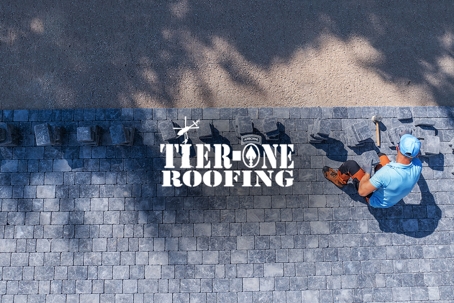Your Trees Are Closer to Your Roof Than You Think—And That’s a Problem
A big shade tree over your home looks beautiful, adds curb appeal, and even cools your house in the summer. But if those branches hang too close to your roof, you’re sitting on a problem waiting to happen. Most homeowners don’t realize how much damage trees can cause—until a storm or even just time itself proves them wrong.
At Tier-One Roofing, we’ve repaired roofs that were damaged by trees more times than we can count. Here’s why trees near your roof can be a big problem, how to know if yours are too close, and what you should do about it.
How Trees Damage Roofs
Falling Branches: Even small limbs can crack shingles or dent metal roofing. Larger limbs can punch straight through decking.
Constant Abrasion: Branches rubbing on shingles during wind events wear away granules and weaken protective layers.
Clogged Gutters: Falling leaves and twigs clog gutters, causing water overflow and hidden leaks.
Increased Moisture & Moss Growth: Shaded roofs often stay damp longer, leading to algae, moss, and shingle decay.
Animal Access: Overhanging branches give squirrels, raccoons, and other pests a pathway onto your roof.
Tier-One Roofing has seen these issues escalate from minor repairs to full roof replacements when ignored.
How Close Is Too Close?
Experts recommend keeping branches at least 10 feet away from your roof. But many Oklahoma homes have branches resting on or just a few feet above their roofline. That’s especially dangerous when storms hit—because wind speeds magnify the force of moving branches.
Signs your trees are too close:
Branches touch or hover over your roof.
Gutters constantly fill with leaves or seed pods.
Moss or algae are visible on shaded roof areas.
You hear scraping or tapping during wind events.
If you’re unsure, Tier-One Roofing can evaluate your roofline and identify areas at risk.
The Storm Factor
During storms, branches that were harmless one day can be catastrophic the next:
High winds can snap limbs or uproot trees.
Ice storms add weight, causing limbs to break.
Lightning strikes often hit tall trees, splitting branches onto roofs.
We’ve seen single branches cause thousands of dollars in damage—and in some cases, entire trees compromise a roof structure.
Tier-One Roofing responds to emergency storm damage, including tree impacts. We remove debris, cover exposed areas, and repair roofs quickly to prevent further issues.
The Hidden Problems Trees Cause
Even if a branch never falls, trees can silently shorten your roof’s lifespan:
Blocked sunlight: Keeps shingles damp, encouraging mold and moss.
Debris buildup: In valleys and gutters leads to water backup and leaks.
Animal nesting: Squirrels, birds, and raccoons use branches to access attics.
These are slow, progressive problems you might not notice until major repairs are needed.
Preventing Tree-Related Roof Damage
Regular Trimming: Keep branches at least 10 feet from the roof.
Annual Roof Inspections: Especially after major storms or heavy winds.
Clean Gutters Frequently: Prevent clogging and overflow damage.
Watch for Signs of Moss or Algae: Address early before it spreads.
Remove Dangerous Trees: Especially those leaning toward the house or showing signs of rot.
Tier-One Roofing offers full inspections to identify areas where tree proximity could be hurting your roof and recommends steps to fix it.
Why Homeowners Delay—and Why That’s a Mistake
Many homeowners delay tree trimming because:
They love the shade and look.
It seems expensive or inconvenient.
They underestimate risk (“That tree’s been there for 30 years…”).
But storms don’t care how long your tree has stood. Waiting often means a preventable branch strike turns into an insurance claim—or worse, an out-of-pocket roof replacement because tree maintenance isn’t always covered.
Proactive care is cheaper and safer than emergency repair.
How Tier-One Roofing Helps
We’re not tree trimmers, but we know roofs—and how trees affect them. When we inspect your home, we:
Evaluate tree proximity and potential branch hazards.
Check for abrasion damage or gutter issues caused by debris.
Recommend preventative measures (like trimming or gutter guards).
Provide documentation for insurance if tree risk is a factor.
Our mission is simple: protect your roof and your home from preventable problems.
Your Next Step
Take a walk around your house today and look up. Are branches brushing your roof? Is there heavy shade or constant debris? If so, it’s time to act.
Call Tier-One Roofing for a free roof inspection. We’ll identify tree-related risks, inspect for hidden damage, and give you a plan to keep your home safe and secure.
Because a beautiful tree should add value to your home—not take years off your roof’s life.

